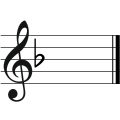D minor
 | |
| Relative key | F major |
|---|---|
| Parallel key | D major |
| Dominant key | A minor |
| Subdominant | G minor |
| Component pitches | |
| D, E, F, G, A, B♭, C, D | |
D minor is a minor scale based on D, consisting of the pitches D, E, F, G, A, B♭, and C. In the harmonic minor, the C is raised to C♯. Its key signature has one flat (see below: Scales and keys).
Its relative major is F major, and its parallel major is D major. D minor is one of the two flat-signature keys whose melodic and harmonic scale variations require the addition of a written sharp; the other is G minor.
Of Domenico Scarlatti's 555 keyboard sonatas, 151 are in minor keys, and with 32 sonatas, D minor is the most often chosen minor key. Nigel Tufnel, one of the members of the musical spoof megagroup Spinal Tap speaks of "a musical trilogy I'm working on in D minor which is the saddest of all keys, I find. People weep instantly when they hear it, and I don't know why."[1]
J. S. Bach's entire The Art of Fugue is in D minor. According to Alfred Einstein, the history of tuning has led D minor to be associated with counterpoint and chromaticism (for example, the chromatic fourth), and cites Mozart's chromatic fugue in D minor.[2] Mozart's Requiem is also written primarily in D minor, as is the aria "Der Hölle Rache". Of the two piano concertos that Mozart wrote in a minor key, one of them is in D minor, No. 20, K. 466. Sibelius's Violin Concerto is in D minor, as is Schumann's. The tonality of D minor held special significance for Helene and Alban Berg.[3]
Michael Haydn wrote only one symphony in a minor key, in D minor, Perger 20, MH 393.
The only chamber music compositions in D minor by Ludwig van Beethoven were his stormy Piano Sonata Op. 31/2 and the haunting Largo of the Ghost Trio Op. 70/1. Since D minor is the key of Beethoven's Symphony No. 9, Bruckner felt apprehensive about writing his own Ninth Symphony in the same key.[4] As well as Bruckners First Mass, some other post-Beethoven symphonies are in D minor, including the only Symphony written by César Franck and Symphony No. 3 by Gustav Mahler.
A fair deal of Gabriel Fauré's chamber music is written in the key of D minor, including the Piano Trio Op. 120, the First Piano Quintet Op. 89 and the First Cello Sonata Op. 109.
Works in the classical music era and later beginning in minor typically end in major, or at least on a major chord (as picardy third), but there are a few notable examples of works in D minor ending in much sharper keys. Two symphonies that begin in D minor and end in E major are Havergal Brian's Gothic Symphony and Nielsen's Symphony No. 4 (The Inextinguishable). Bruckner's Ninth Symphony, which is often performed without the finale, is another example of a symphony beginning in D minor and ending in E major. Liszt's Dante Symphony opens in D minor and ends in B major.
Similar to a D minor symphony ending in D major, a D major symphony can have for its allegro first movement a slow introduction in D minor. "Tonic minor Adagio introductions, especially in the key of D minor, were very popular with English composers of the year 1794," and Joseph Haydn copied this procedure for the D major symphonies he wrote in London.[5]
Film composer Hans Zimmer is one of the most prominent users of the key of D minor in modern times. Many of his well-known scores were written in the key, notable examples including Gladiator, The Dark Knight, Pirates of the Caribbean, and The Da Vinci Code. His frequent use of the key has been noticed by reviewers such as Christian Clemmensen of Filmtracks, calling the trend "ridiculous stubbornness."[6]
See also
Notes
- ↑ Ratliff, Ben (2009). The Jazz Ear: Conversations Over Music, p. 28. ISBN 9780805090864.
- ↑ Alfred Einstein, Mozart, His Character, His Work, Chapter 10, "Mozart's Choice Of Keys", New York: Oxford University Press (1945)
- ↑ Pople, Anthony (1997). "Early Works: Tonality and Beyond", The Cambridge Companion to Berg, p. 81. Pople, Anthony, ed. ISBN 0-521-56489-1.
- ↑ Hans-Hubert Schönzeler, Bruckner London: Calder & Boyars Ltd (1978): 106 – 107. According to Göllerich, he [Bruckner] made the remark: "It really annoys me that the theme of my new symphony is in D minor, because everybody will say now: 'Of course, Bruckner's Ninth must be in the same key as Beethoven's!'"
- ↑ H. C. Robbins Landon, Supplement to The Symphonies of Joseph Haydn London: Barrie & Rockliff (1961): 47
- ↑ Clemmensen, Christian. "The Dark Knight Rises Review". Filmtracks. Retrieved 1 August 2012.
Further reading
- Sherman, Charles H. Johann Michael Haydn (1737–1806), a chronological thematic catalogue of his works New York: Pendragon Press, 1993.
| Diatonic scales and keys | |||||||||||||||||||||||||||||||||||||||||||||||||||||||
|---|---|---|---|---|---|---|---|---|---|---|---|---|---|---|---|---|---|---|---|---|---|---|---|---|---|---|---|---|---|---|---|---|---|---|---|---|---|---|---|---|---|---|---|---|---|---|---|---|---|---|---|---|---|---|---|
 |
| ||||||||||||||||||||||||||||||||||||||||||||||||||||||
| The table indicates the number of sharps or flats in each scale. Minor scales are written in lower case. | |||||||||||||||||||||||||||||||||||||||||||||||||||||||